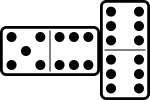No Of Players: 2 to 4 players
Domino Set: Double-six
Objective:
Draw Dominoes game is one of the simplest variant of domino games sometimes also referred to as The Draw Game. The game is played for multiple rounds with objective to be the first to score 100 points. Points are calculated at the end of each round. Final winning score can be decided by the players to be less than 100 at the beginning for a shorter game play.
Setup:
All domino tiles are shuffled at the beginning of the game and then each player draws tiles face-down to make up his hand
- For 2 players game each player draws 7 tiles
- For 3 or 4 players game each player draws 5 tiles
Remaining tiles are set aside to form the stock pile. The stock pile is normally referred to as the Boneyard. Players can only see their own tiles.
Draw Dominoes is played similar to Block Dominoes with one difference. In Draw Dominoes players can draw tiles from the boneyard whereas in Block Dominoes players could not draw tiles from the boneyard.
First Turn:
First turn is decided by using one of the two alternate ways (similar to Block Dominoes)
- Player with highest double (domino tile having same number of pips on both ends)
- Player with highest tile (sum of pips on both ends)
The rule for first turn is determined at the beginning of the game. Since players can only see their own tiles, in order to find out who gets to start the turn, one player asks depending upon the rules. For ex; for highest-double rule player asks if someone has 6-6, if no one has it, then 5-5 and so on. For highest-tile rule, player asks if someone has tile with value 12, if not then 11, and so on.
In highest-double rule, if no players gets a double, then domino tiles are collected from all players, shuffled and re-drawn.
Game Play:
Once first domino tile has been played, turn is passed clockwise to the next player. Next player can play a tile only if one end of the tile matches either of the two open ends of domino tile(s) already played in the game.
For ex; If a double-six was played as following

Then any tile with one of its end having a 6 can be played as shown below. Matching sides should always be placed adjacent to each other making non-matching end to be the open-end.

If player does not have a matching tile, then he must draw a tile from the boneyard and play immediately if it can be played. The player continues to draw tile from the boneyard until he can find a matching tile to play immediately. If boneyard has no tile left to draw, then turn is passed to the next player. Doubles are always played in vertical orientation and non-doubles are played in horizontal orientation. The game always has two open ends and players are free to play to any of the two ends.
The round continues in this way until
- Either one of the players has played all his tiles
- Or none of the players has a matching tile to play and there is no tile to draw from the boneyard. In this scenario the game is said to be blocked.
The round ends in either of the two scenarios. After the end of the round remaining tiles in the player’s hands are turned face-up to count for scoring.
Scoring:
At the end of the round points are awarded to the winner. The player with the lowest hand score in a round wins the points which is sum total of all other players’ hand score minus hand score of the winner.
For ex; if players’ hand scores are 2, 3, 5, and 8 then player with hand score of 2 wins 14 points for the round (3 + 5 + 8 – 2).
In case two or more players have the same hand score at the end of a round which is also the lowest hand score then all players with the same hand score win points for that round.
For ex; if players’ hand scores are 3, 3, 7, and 8 then players with hand score of 3 win 12 points for the round (7 + 8 – 3).
The current round’s score is added to the overall score of the player. If the overall winning total has not yet reached, then game continues to the next round.
Draw Dominoes Game Illustration

Variation:
The game can be played with larger domino sets (like double-nine or double-twelve) which can be used if more than 4 players are playing.
The number of tiles drawn by players can also vary which can be determined by players at the beginning of the game.